Purpose built as a supermarket in the 1970s, these premises stand on the site of Sidney Croydon’s Printing and Publishing Works. Croydon also owned the steam laundry next door. Henrietta Paddon worked in the steam laundry in the early 1900s. In 1925, her husband teamed up with Commander EG Martin to win the first 600-mile Fastnet Race in the gaff-rigged pilot cutter Jolie Brise. She is the only vessel to have won the race three times.
Text about The Jolie Brise.
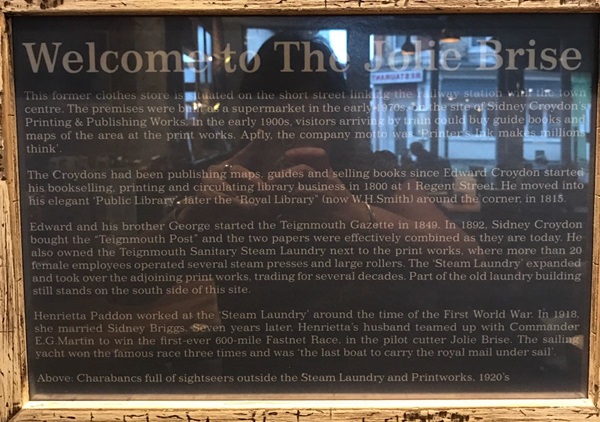
The text reads: This former clothes store is situated on the short street linking the railway station with the town centre. The premises were built as a supermarket in the early 1970s on the site of Sidney Croydon’s Printing & Publishing Works. In the early 1900s, visitors arriving by train could buy guide books and maps of the area at the print works. Aptly, the company motto was ‘Printer’s Ink makes millions think’.
The Croydon’s had been publishing maps, guides and selling books since Edward Croydon started his bookselling, printing and circulating library business in 1800 at 1 Regent Street. He moved into his elegant Public Library, later the Royal Library (now W.H.Smith) around the corner, in 1815.
Edward and his brother George started the Teignmouth Gazette in 1849. In 1892, Sidney Croydon bought the Teignmouth Post and the two papers were effectively combined as they are today. He also owned the Teignmouth Sanitary Steam Laundry next to the print works, where more than 20 female employees operated several steam presses and large rollers. The Steam Laundry expanded and took over the adjoining print works, trading for several decades. Part of the old laundry building still stands on the south side of this site.
Henrietta Paddon worked at the Steam Laundry around the time of the First World War. In 1918, she married Sidney Briggs. Seven years later, Henrietta’s husband teamed up with Commander EG Martin to win the first-ever 600-mile Fastnet Race, in the pilot cutter Jolie Brise. The sailing yacht won the famous race three times and was ‘the last boat to carry the royal mail under sail’.
An illustration and text about John Keats in Teignmouth.
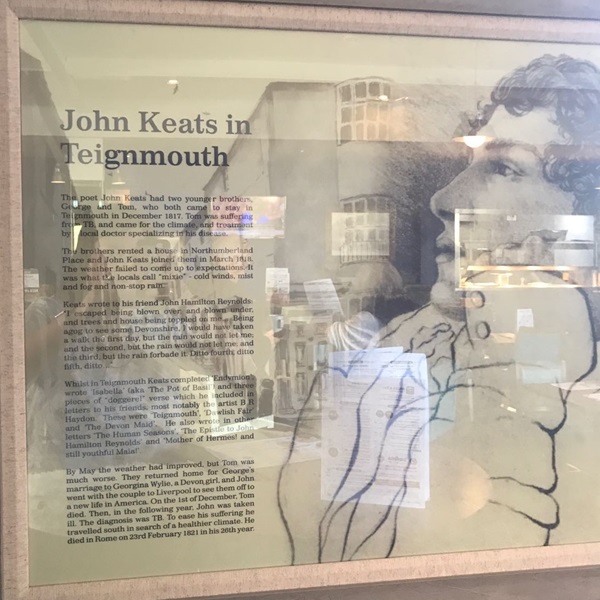
The text reads: The poet John Keats had two younger brothers, George and Tom, who both came to stay in Teignmouth in December 1817. Tom was suffering from TB, and came for the climate, and treatment by a local doctor specialising in his disease.
The brothers rented a house in Northumberland Place and John Keats joined them in March 1818. The Weather failed to come up to expectations. It was what the locals call “mixie” – cold winds, mist and fog and non-stop rain.
Keats wrote to his friend John Hamilton Reynolds: “I escaped being blown over, and blown under, and trees and house being toppled on me … Being agog to see some Devonshire, I would have taken a walk the first day, but the rain would not let me; and the second, but the rain would not let me; and the third, but the rain forbade it. Ditto fourth, ditto fifth, ditto…”
Whilst in Teignmouth Keats completed Endymion, wrote Isabella (aka The Pot of Basil) and three pieces of “doggerel’ verse which he included in letters to his friends, most notably the artist BR Haydon. These were Teignmouth, Dawlish Fair and The Devon Maid. He also wrote in other letters The Human Seasons, The Epistle to John Hamilton Reynolds and Mother of Hermes! And still youthful Maia.
By May the weather had improved, but Tom was much worse. They returned home for George’s marriage to Georgina Wylie, a Devon girl, and John went with the couple to Liverpool to see them off to a new life in America. On the 1st of December, Tom died. Then, in the following year, John was taken ill. The diagnosis was TB. To ease his suffering he travelled south in search of a healthier climate. He died in Rome on 23 February 1821 in his 26 year.
Illustrations and text about Thomas Luny, marine artist.
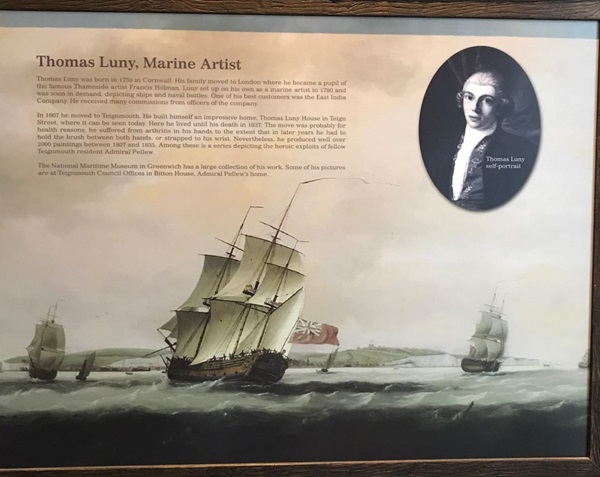
The text reads: Thomas Luny was born in 1759 in Cornwall. His family moved to London where he became a pupil of the famous Thameside artist Francis Holman. Luny set up on his own as a marine artist in 1780 and was soon in demand, depicting ships and naval battles. One of his best customers was the East India Company. He received many commissions from officers of the company.
In 1807 he moved to Teignmouth. He built himself an impressive home. Thomas Luny House in Teign Street, where it can be seen today. Here he lived until his death in 1837. The move was probably for health reasons: he suffered from arthritis in his hands to the extent that in later years he had to hold the brush between both hands, or strapped to his wrist. Nevertheless, he produced well over 2000 paintings between 1807 and 1835. Among these is a series depicting the heroic exploits of fellow Teignmouth resident Admiral Pellew.
The National Maritime Museum of Greenwich has a large collection of his work/ some of his pictures are at Teignmouth Council Offices in Bitton House, Admiral Pellew’s home.
Text about Charles Babbage.
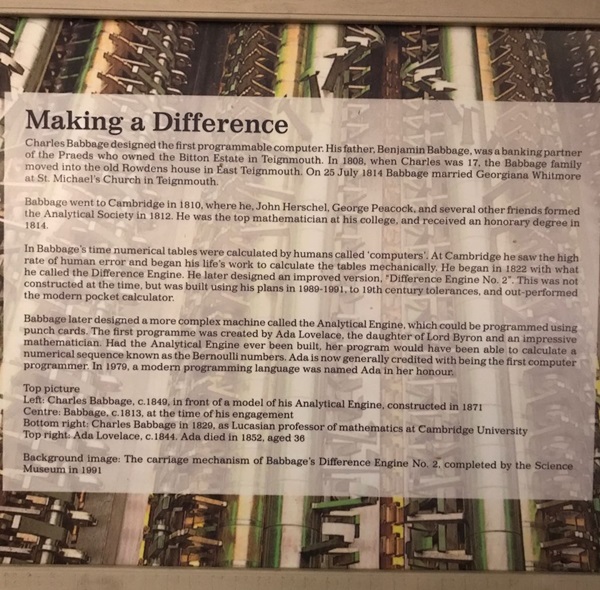
The text reads: Charles Babbage designed the first programmable computer. His father, Benjamin Babbage, was a banking partner of the Praeds who owned the Bitton Estate in Teignmouth. In 1808, when Charles was 17, the Babbage family moved into the old Rowdens house in East Teignmouth. On 25 July 1814 Babbage married Georgiana Whitmore at St. Michael’s Church in Teignmouth.
Babbage went to Cambridge in 1810, where he, John Herschel, George Peacock, and several other friends formed the Analytical Society in 1812. He was the top mathematician at his college, and received an honorary degree in 1814.
In Babbage’s time numerical tables were calculated by humans called ‘computers’. At Cambridge he saw the high rate of human error and began his life’s work to calculate the tables mechanically. He began in 1822 with what he called the Difference Engine. He later designed an improved version, Difference Engine No.2. This was not constructed at the time, but was built using his plans in 1989-1991, to 19th century tolerances, and out-performed the modern pocket calculator.
Babbage later designed a more complex machine called the Analytical Engine, which could be programmed using punch cards. The first programme was created by Ada Lovelace, the daughter of Lord Byron and an impressive mathematician. Had the Analytical Engine ever been built, her program would have been able to calculate a numerical sequence known as the Bernoulli numbers. Ada is now generally credited with being the first computer programmer. In 1979, a modern programming language was named Ada in her honour.
Text about Donald Crowhurst.
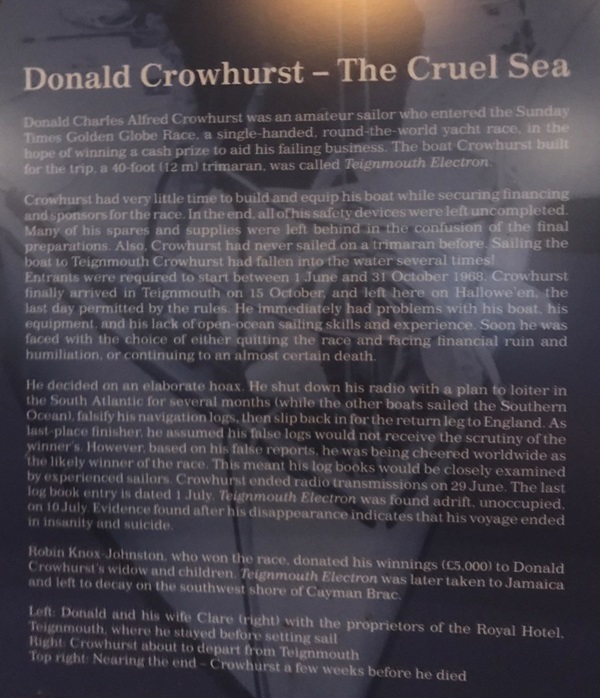
The text reads: Donald Charles Alfred Crowhurst was an amateur sailor who entered the Sunday Times Golden Globe Race, a single-handed, round-the-world yacht race, in the hope of winning a cash prize to aid his failing business. The boat Crowhurst built for the trip, a 40-foot (12m) trimaran, was called Teignmouth Electron.
Crowhurst had very little time to build and equip his boat while securing financing and sponsors for the race. In the end, all of his safety devices were left uncompleted. Many of his spares and supplies were left behind in the confusion of the final preparations. Also, Crowhurst had never sailed on a trimaran before. Sailing the boat to Teignmouth, Crowhurst had fallen into the water several times! Entrants were required to start between 1 June and 31 October 1968. Crowhurst finally arrived in Teignmouth on 15 October, and left here on Halloween, the last day permitted by the rules. He immediately had problems with his boat, his equipment, and his lack of open-ocean sailing skills and experience. Soon he was faced with the choice of either quitting the race and facing financial ruin and humiliation, or continuing to an almost certain death.
He decided on an elaborate hoax. He shut down his radio with a plan to loiter in the South Atlantic for several months (while the other boats sailed the Southern Ocean), falsify his navigation logs, then slip back in for the return leg to England. As last-place finisher, he assumed his false logs would not receive the scrutiny of the winner’s. However, based on his false reports, he was being cheered worldwide as the likely winner of the race. This meant his log books would be closely examined by experienced sailors. Crowhurst ended radio transmissions on 29 June. The last log book entry is dated 1 July. Teignmouth Electron was found adrift, unoccupied, on 10 July. Evidence after his disappearance indicates that his voyage ended in insanity and suicide.
Robin Knox-Johnston, who won the race, donated his winnings (£5,000) to Donald Crowhurst’s widow and children. Teignmouth Electron was later taken to Jamaica and left to decay on the southwest shore of Cayman Brac.
Photographs and text about Jolie Brise – an icon among ocean racers.
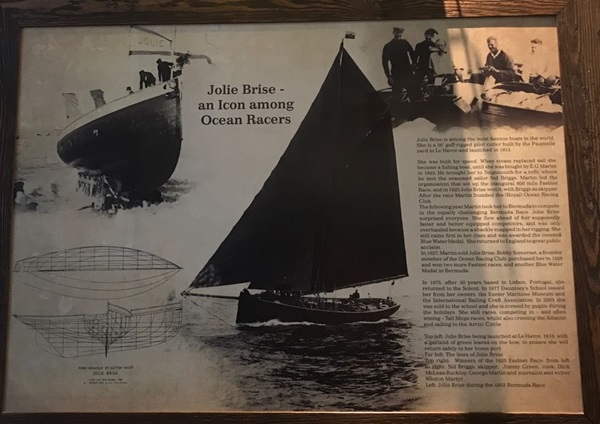
The text reads: Jolie Brise is among the most famous boats in the world. She is a 56’ gaff-rigged pilot cutter built by the Paumelle yard in Le Havre and launched in 1913.
She was built for speed. When steam replaced sail she became a fishing boat, until she was bought by EG Martin in 1923. He brought her to Teignmouth for a refit, where he met the seasoned sailor Sid Briggs. Martin led the organisation that set up the inaugural 600 mile Fastnet Race, and in 1925 Jolie Brise won it, with Briggs as skipper. After the race Martin founded the (Royal) Ocean Racing Club.
The following year Martin took her to Bermuda to compete in the equally challenging Bermuda Race. Jolie Brise surprised everyone. She flew ahead of her supposedly faster and better equipped competitors, and was only overhauled because a shackle snapped in her rigging. She still came first in her class and was awarded the coveted Blue Water Medal. She returned to England to great public acclaim.
In 1927, Martin sold Jolie Brise. Bobby Somerset, a founder member of the Ocean Racing Club, purchased her in 1928 and won two more Fastnet races, and another Blue Water Medal in Bermuda.
In 1975, after 30 years based in Lisbon, Portugal, she returned to the Solent. In 1977 Dauntsey’s School leased her from her owners, the Exeter Maritime Museum and the International Sailing Craft Association. In 2003 she was sold to the school and she is crewed by pupils during the holidays. She still races, competing in – and often winning – Tall Ships races, whilst also crossing the Atlantic and sailing to the Arctic Circle.
Top left: Jolie Brise being launched at Le Havre, 1913, with a garland of green leaves on the bow, to ensure she will return safely to her home port
Far left: The lines of Jolie Brise
Top right: Winners of the 1925 Fastnet Race from left to right. Sid Briggs, skipper; Jimmy Green, cook; Dick McLean Buckley; George Martin and journalist and writer Weston Martyr
Left: Jolie Brise during the 1932 Bermuda Race.
Text about the Morgan Giles connection.
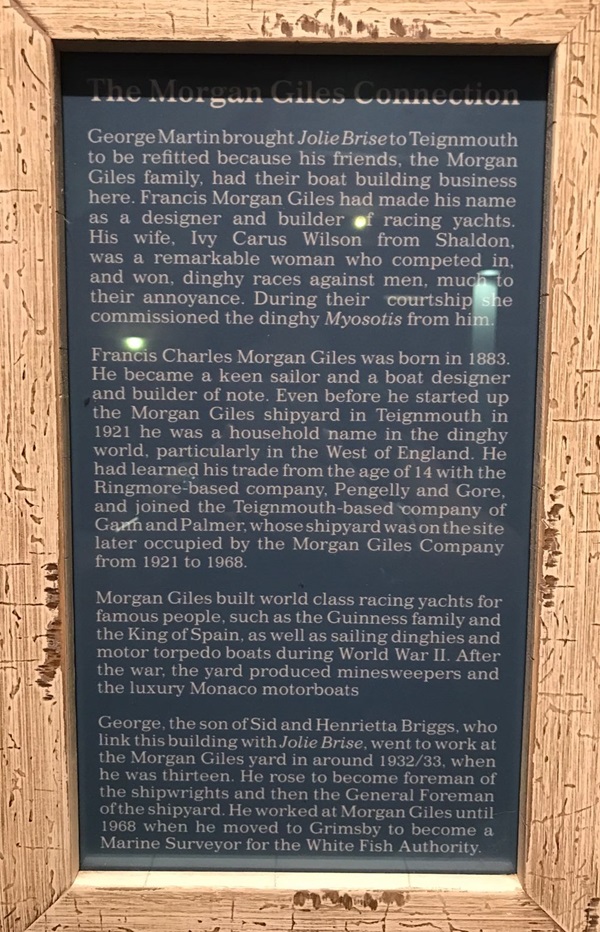
The text reads: George Martin brought Jolie Brise to Teignmouth to be refitted because his friends, the Morgan Giles family, had their boat building business here. Francis Morgan Giles had made his name as a designer and builder of racing yachts. His wife, Ivy Carus Wilson from Shaldon, was a remarkable woman who competed in, and won, dinghy races against men, much to their annoyance. During their courtship she commissioned the dinghy Myosotis from him.
Francis Charles Morgan Giles was born in 1883. He became a keen sailor and a boat designer and builder of note. Even before he started up the Morgan Giles shipyard in Teignmouth in 1921 he was a household name in the dinghy world, particularly in the West of England. He had learned his trade from the age of 14 with the Ringmore-based company, Pengelly and Gore, and joined the Teignmouth-based company of Garth and Palmer, whose shipyard was on the site later occupied by the Morgan Giles Company from 1921 to 1968.
Morgan Goles built world class racing yachts for famous people, such as the Guinness family and the King of Spain, as well as sailing dinghies and motor torpedo boats during World War II. After the war, the yard produced minesweepers and the luxury Monaco motorboats.
George, the son of Sid and Henrietta Briggs, who link this building with Jolie Brise, went to work at the Morgan Giles yard in around 1932/33, when he was thirteen. He rose to become foreman of the shipwrights and then the general foreman of the shipwrights and then the general foreman of the shipyard. He worked at Morgan Giles until 1968 when he moved to Grimsby to become a Marine Surveyor for the White Fish Authority.
A photograph and text about Station Road, c1910.
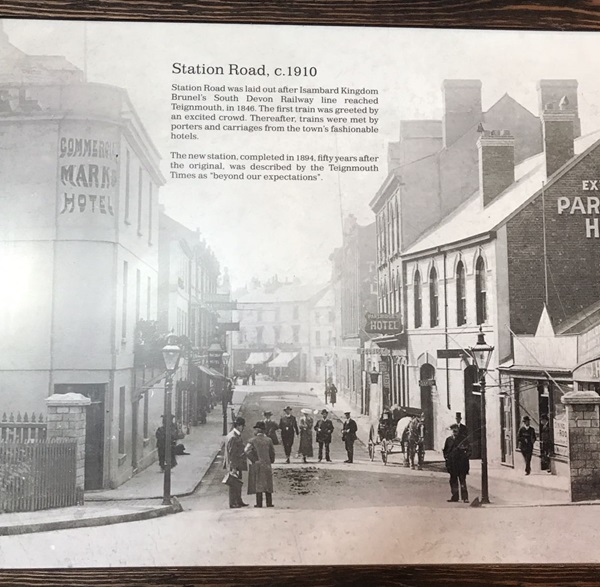
The text reads: Station Road was laid out after Isambard Kingdom Brunel’s South Devon Railway line reached Teignmouth, in 1846. The first train was greeted by an excited crowd. Thereafter, trains were met by porters and carriages from the town’s fashionable hotels.
The new station, completed in 1894, fifty years after the original, was described by the Teignmouth Times as “beyond our expectations”.
Photographs and text about the South Devon Railway.
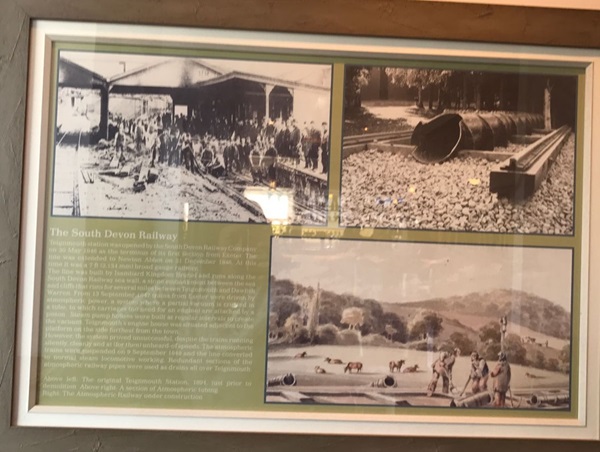
The text reads: Teignmouth station was opened by the South Devon Railway Company on 30 May 1846 as the terminus of its first section from Exeter. The line was extended to Newton Abbot on 21 December 1846.
External photograph of the building – main entrance.
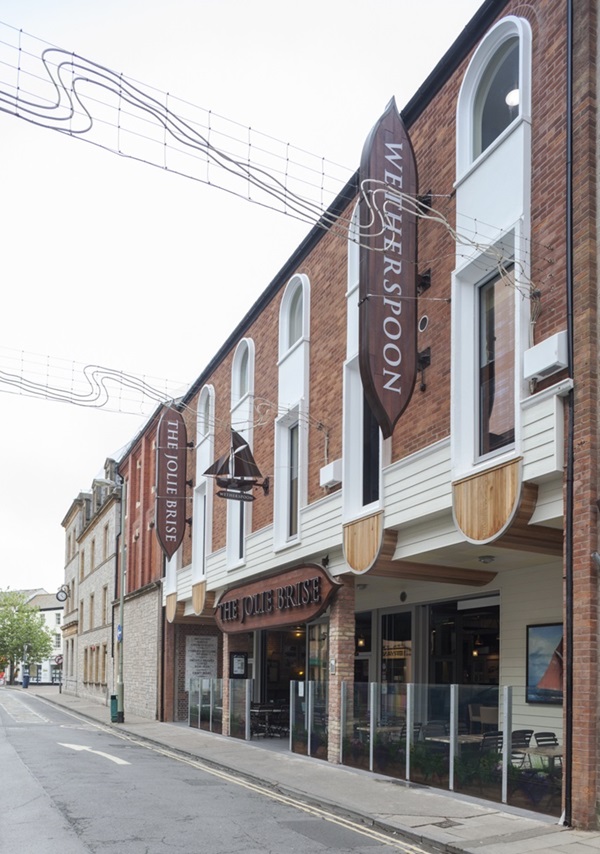
If you have information on the history of this pub, then we’d like you to share it with us. Please e-mail all information to: pubhistories@jdwetherspoon.co.uk